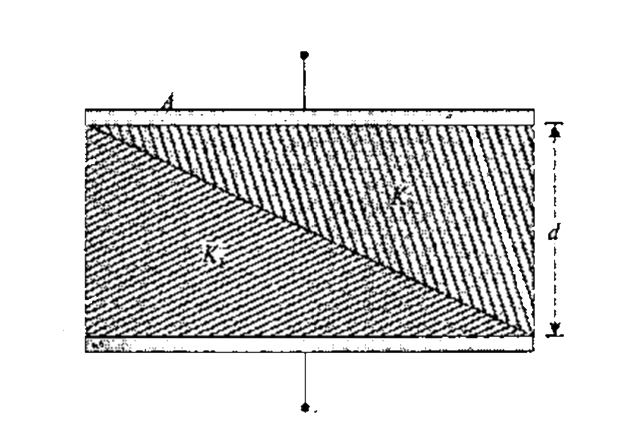`((CK_1K_2)/(K_2-K_1)1n(K_2)/(K_1),)` let length of breath of the capacitor be /and b respectively and be the distance between the plates as shown figures then, consider a strip at a distance x if widh dx.
Now, `QR=xtan theta and PQ =d-x tan theta`
Where `tan theta =d//1 , ` capacitor of `PQ`
`C_1=(K_1epsilon _0(bdx))/(d-x tan theta)=(K_1epsilon_0(bdx))/(d-(xd)/1)`
`C_1=(K_1epsilonb//dx)/(d(1-x))=(K_1epsilon_0A(dx))/(d(1-x)) and C_1="capicitor of QR"=(K_2epsilon_0b(dx))/(x tan theta)`
`C_1=(K_2epsilon_0A(dx))/(xd) (tantheta=d/1)`
Now `C_1` and `C_2` are in series.Therefore,their resultant capacity `C_0` will be given by `1/(C_0)=1/(C_1)+1/(C_2)`
Then `1/(C_0)=1/(C_2)+1/(C_2)=(d(1-x))/(K_1epsilon_0A(dx))+(xd)/(K_2epsilon_0A(dx))1/c_0=d/(epsilon_0A(dx))((1-x)/(K_1)+x/(k_2))=(d{K_(2)(1-x)+K_(1)x})/epsi_(0)AK_(1)K_(2)(dx)`
`C_(0)=(epsi_(0)AK_(1)K_(2))/(D{K_(2)(1-x)+K_(1)x})dx, C_(0)=(epsi_(0)AK_(1)K_(2))/(d{K_(2)I+(K_(1)=K_(2))x})dx`
Now, the net capacitance of the given parallel plate capacitor is obtained by adding such infinitesimal capacitors placed parallel from `x=0` to `x=1`
i.e., Finally we get `C_(n)=(K_(1)K_(2)A)/((K_(2)_K_(1))d)ln(K_(2))/(K_(1))=(CK_(1)K_(2))/(K_(2)-K_(1))ln(K_(2))/(kK_(1))`, where `C=(epsi_(0)A)/(d)`.


